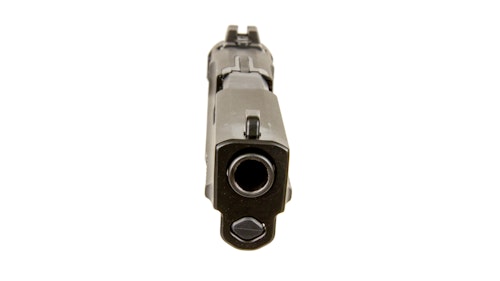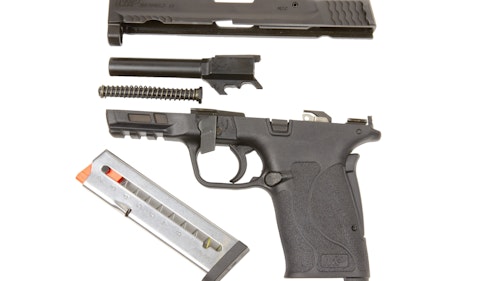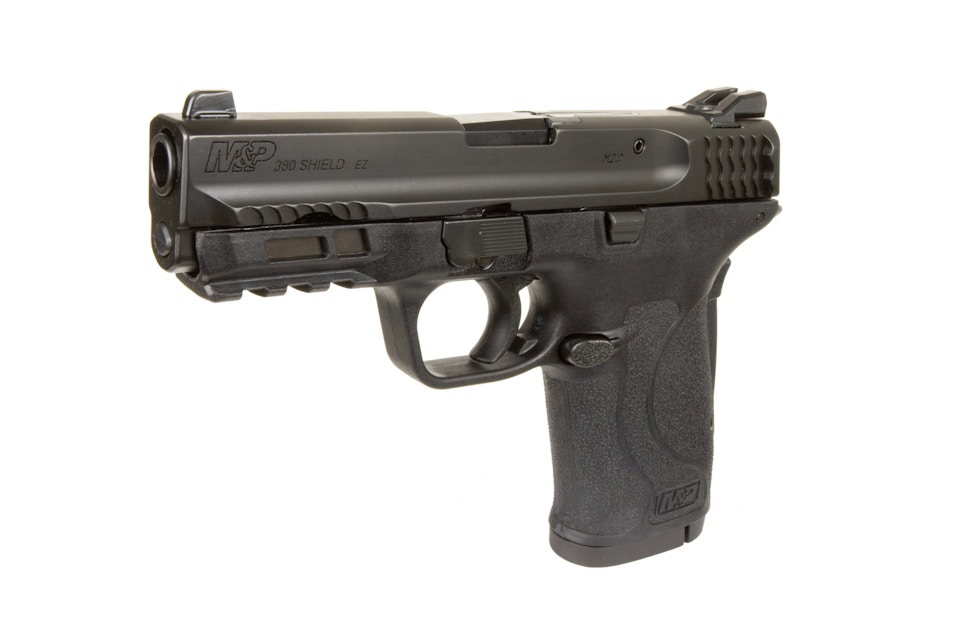Some people just don’t have the hand strength that others do. They can’t grip things as tightly. It affects both men and women and can be particularly troublesome when it comes to racking the slide on a semi-automatic pistol.
Smith & Wesson decided to do something about it. S&W developed the Shield EZ line of pistols chambered in .380 Auto and 9mm Luger. S&W calls them the M&P380 Shield EZ and M&P9 Shield EZ. And the major selling difference between the EZ line and other semi-automatic handguns in the same caliber is that the EZ guns take less force to withdraw the slide to cycle the gun.
Using a Brownells Recording Trigger Pull Gauge, I tested the force required to pull the slide all the way to the rear on both an M&P9 Shield EZ and M&P380 Shield EZ. I then compared the results with the force required to pull the slide on other guns chambered for the same round.
The average force needed to cycle the slide on the sample M&P9 Shield EZ was about 12.9 pounds. The average force needed for a full-size M&P9 was about 16.25 pounds — considerably more.
The average force needed to retract the slide all the way to the rear of the sample M&P380 Shield EZ was about 13.75 pounds while it took about 11.6 pounds to cycle the slide on a sample .380 Auto Remington RM380. It took about 11.6 pounds to rack the slide on a Ruger LCP in .380 Auto. While both comparison guns required less force to cycle the slide, it is important to note that there is very little area to grip the slide on the RM380 and LCP compared to the M&P380.
And that lack of area makes a huge difference. The result is that although it might take more force to cycle the M&P380 slide, it seems like much less. For someone who has less grip strength, holding onto the slide to cycle it is going to be much more difficult with the smaller RM380 and LCP than it will be with the M&P380 Shield EZ.

Safety Features
Besides being a little easier to rack for people with less grip strength, both Shield EZ pistols have some other nice features. And while some EZ handguns come with a thumb safety for those who do not feel comfortable carrying a gun without one, others have no thumb safety. So, the buyer has a choice. But the EZ series also comes with a grip safety. Some people hate grip safeties, but I happen to like them. I’ve never had a problem manipulating them and the gun fires whenever I pull the trigger, but they can be a problem for some people. There are fixes for that though.
One advantage of a grip safety is the ability to make the gun less likely to fire unintentionally when the gun is holstered. It’s simple training. Just relax the grip on the gun a little by moving the firing-hand thumb from its normal position to the rear of the slide. For most people, that should release the grip safety. Then carefully insert the handgun into the holster. Many unintentional discharges occur during holstering, and this technique can reduce the likelihood of one.
But be careful not to depress the grip safety during the assembly process. Doing so will prevent the slide from traveling all the way to the rear of the frame. Not a big deal and it doesn’t require any special technique, but it is something the owner should be aware of and something you can pass along to your customer. It might prevent some phone calls or returns.
The EZ Shields both have loaded chamber indicators and they are not just a viewing port in the top of the slide. Instead, the indicator is a metal lever that protrudes slightly from the top of the slide when a round is chambered. It can be seen and felt so it’s useful in bright conditions and dark. But it should not be relied upon as the only check for a loaded chamber. That’s because it’s a mechanical device and it could malfunction. That’s Murphy’s Law.
So, encourage your customers to get training and learn how to do a visual and tactile chamber check with a handgun. It could save their life or someone else’s. No one wants to find themselves with an unloaded gun when they need a loaded one, and no one should have a loaded gun when they think it’s unloaded. Proper techniques learned from a competent instructor can help to prevent both.
Smooth Pull
Factory triggers these days are usually pretty dismal when compared to aftermarket or custom triggers, but the ones on both test guns were surprisingly good. They are not in the class of a trigger tuned by a good gunsmith, but they are better than those usually found on guns straight from the factory these days.
The weight or force required to pull the trigger on the test M&P380 was 4 pounds, 10.7 ounces on average and on the M&P9 it was 4 pounds, 12.9 ounces. Both had a small bit of take-up, some minor creep and a clean break. There was no discernable overtravel on either. That’s not bad for triggers right off the assembly line.
Both test guns had standard white three-dot iron sights. The rear on both guns were drift adjustable after loosening a set screw accessible from the bottom of the slide, but the front could be drifted left or right only on the M&P9. The front sight on the M&P380 was inserted into a hole and locked in place with a retention clip. Other sight options are available.

Built Alike
The two guns are almost identical in size. But, surprisingly, the M&P9 feels just a little larger in hand than the M&P380. Front to back, with the grip safety depressed, the M&P380 grip measures 2.00 inches and the M&P9 measures 2.06 inches. Side to side, the dimensions are 0.95 inch and 1.00 inch. The circumferences are 5 1/8 inch and 5 1/4 inch. Only your customer can decide which one feels best.
The magazine release is located where expected, just behind the junction of the trigger guard and front strap. When depressed, magazines dropped freely away on both guns. And a nice feature is that the release can be moved from the left side to the right by the owner.
The M&P380 weighs 18.5 ounces and the M&P9 weighs 23.1 ounces. That’s not much difference even when loaded, but once again the customer will have to decide if the difference is worth consideration. Both guns have stainless steel barrels and slides that are finished with Armornite, a hard, corrosion-resistant black finish. The serrations at the rear and front of the slide are scallops or scales that look very nice. They work too, although the serrated area on the front of the slides is very small and doesn’t offer much of a gripping surface.
Both guns have polymer frames and are hammer fired, although the hammer is hidden by the slide. The grips on both are nicely textured and offer a good slip-resistant surface. And the magazines for both hold eight rounds. Each gun sports an accessory rail with three slots. Accessory rails are becoming more common these days and are a nice feature because they allow the attachment of lights or lasers.
Disassembly of the guns for cleaning is straightforward and very similar to other polymer framed semi-automatics. First, after checking and double checking to make sure the gun is not loaded and the magazine is removed, the slide is locked to the rear. Then the takedown lever, located on the left side of the gun just below the slide and a little above the trigger is rotated clockwise 90 degrees. Next, while carefully holding onto the slide so that it isn’t launched by the recoil spring, the slide is eased off the front of the frame.
Once separated from the frame, the recoil spring assembly is removed from the slide after which the barrel is removed. Assembly, as is commonly said, is in reverse order. However, unlike many guns of this sort the recoil spring assembly, which contains the guide rod, must be oriented correctly so that the diamond-shaped front-end fits in the hole in the front of the slide.
Comfortable Shooting
Shooting the guns was a pleasure. Although the 9mm has a bit more recoil, it was still easy to shoot. The .380 Auto was even more comfortable to shoot. With the slim profile of both guns, they are going to be a big hit with those customers who want an easily carried but not micro-size gun. And now that ammunition manufacturers have improved .380 bullets so drastically, the difference between the two rounds in terms of self-defense is extremely small.
These are both nice guns that are undoubtedly going to be popular with customers, and they could make an otherwise hesitant buyer ready to part with some cash.






